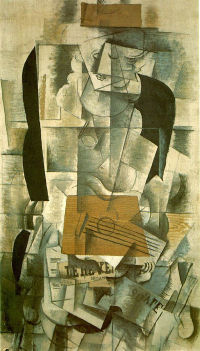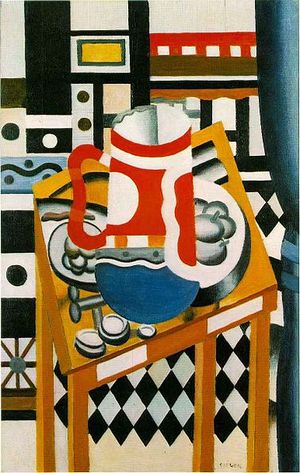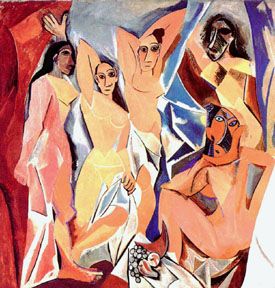Cubism
 From Conservapedia
From Conservapedia 
Cubism is a type of painting (school of art) in which normal shapes of people or other subjects are painted in geometric forms in an attempt to view multiple vantages within a single image - combining multiple views of one object into a coherent whole, styled in a manner intended to appeal to a certain frame of mind. The movement lasted from 1907 to 1916. Cubism could be called a "Fly's eye view of the world". The two types of Cubism are Analytical Cubism and Synthetic Cubism. Prominent Cubists were Pablo Picasso, Georges Braque (1882 - 1963), Juan Gris (1887 - 1927) and Fernand Leger (1881 - 1955). The French art critic Louis Vauxcelles coined the term Cubism after seeing the landscapes Braque had painted in 1908 at L'Estaque in emulation of Cézanne. Vauxcelles called the geometric forms in the highly abstracted works "cubes". Cubism

Cubism was a rebellion against logic,[1] while its rival surrealism was an extension of it.
The famous "Demoiselles d'Avignon" (1907) is often represented as the seminal Cubist work. Pablo Picasso
Fernand Léger emphasis a personal form of "Cubism" called "Tubism" for its cylindrical forms; he did not used the collage technique displayed in Braque and Picasso's works or in Diego Rivera's synthetic cubism.

See also[edit]
- Painting Schools
- Painting Masterpieces
- Diego Rivera
- Famous Spanish Artists
External links[edit]

- Cubism
- Cubism or cubism artlex.com
- Georges Braque
- Fernand Leger
- Juan Gris: The Cubist Intellectual.
- CUBISMO DE DIEGO RIVERA In Spanish.

- ↑ https://www.metmuseum.org/blogs/teen-blog/2015/cubism
Categories: [Artistic Movements]
↧ Download as ZWI file | Last modified: 02/26/2023 16:06:23 | 16 views
☰ Source: https://www.conservapedia.com/Cubism | License: CC BY-SA 3.0
 ZWI signed:
ZWI signed: KSF
KSF